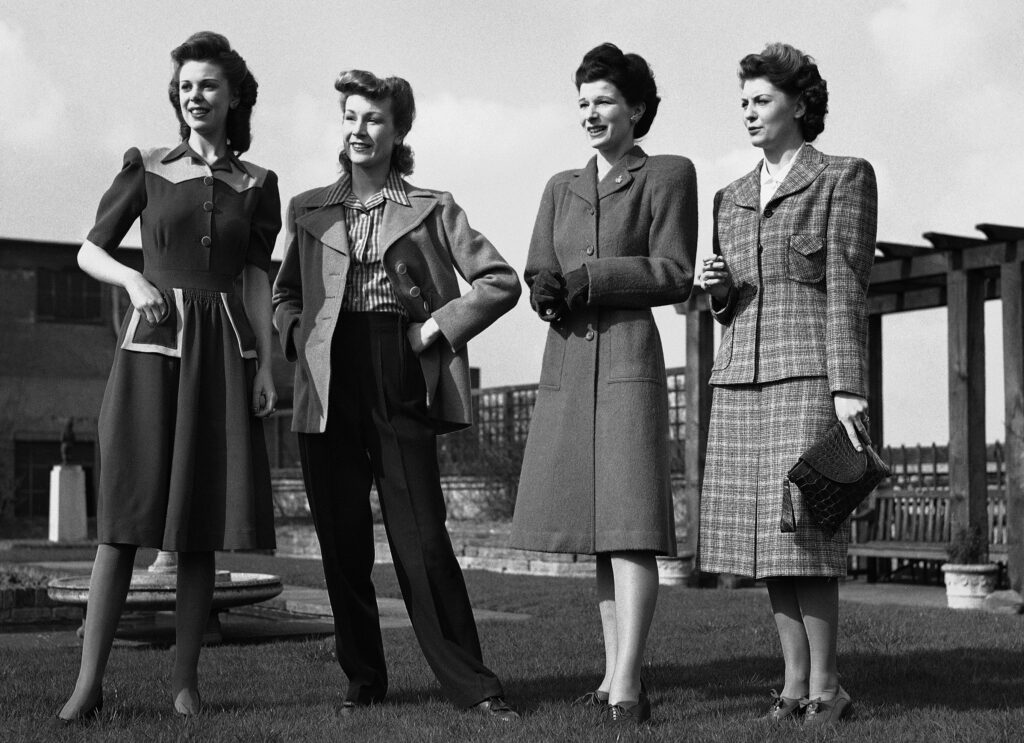
The 1950s women’s fashion represented a monumental shift in style, blending elegance with femininity. Post-World War II, the demand for glamorous, luxurious designs soared. Christian Dior’s “New Look” redefined the fashion landscape with full skirts, cinched waists, and a celebration of the female form. The revolutionary styles of the era remain a timeless source of inspiration.
But this isn’t just a history lesson on 1950s fashion history—it’s a journey customized to you to transport you back to the time of stunning full skirts, nipped waists, and revolutionary fashion trends.
A New Era of Elegance
The Impact of World War II on Fashion
The end of World War II in 1945 marked a significant turning point in the fashion world. The war imposed strict rationing on materials, leading to practical, boxy clothing prioritizing function over style. However, as the world began to heal, women sought a return to femininity. The end of the decade ushered in a longing for glamour, and fashion began to reflect this desire.
In the 1940s, women often wore utilitarian clothing. But as the 1950s approached, a new ethos emerged. Women were ready to reclaim their identities. They wanted to embrace their femininity and express themselves through their clothing. This desire for change set the stage for the fashion innovations that were to come.
Dior’s “New Look”: A Game-Changer
Celebrating the Female Form
Imagine walking into a 1947 post-WWII boutique and seeing Christian Dior’s “New Look” collection for the first time. It was revolutionary. The silhouette—a full skirt, cinched waist, and fitted bodice—celebrated the female form in a way that had not been done since the Edwardian era. This trend exploded into the 1950s and influenced almost every corner of women’s fashion.
Dior’s “New Look” emphasised an hourglass figure, a drastic departure from wartime’s frugality. Women who had been restricted to more functional clothing during the war now had the opportunity to flaunt their curves. The emphasis was on luxury, beauty, and the art of dressing. With wide skirts ruling the decade, women could create dramatic, flowing looks that added a touch of grandeur to everyday fashion. Imagine how glamorous it must have felt to swish through the streets in a 1953-inspired swing dress.
The Silhouette That Changed Everything
Dior’s designs had a profound impact on the fashion world. The silhouette he popularised became synonymous with 1950s fashion. The exaggerated waistlines and voluminous skirts became staples in women’s wardrobes. The “New Look” signified a return to traditional femininity, contrasting sharply with the more androgynous styles of the 1940s.
Women began to embrace various styles, including A-line skirts and pencil skirts. These garments allow for individual expression while maintaining the core elements of Dior’s vision. The pencil skirt, in particular, hugged the hips and accentuated the figure, making it a favourite for both daytime and evening wear.
Skirts, Dresses, and Everything in Between
Diverse Styles for Every Occasion
The 1950s fashion scene was rich with variety. Skirts and dresses were not just clothing items but statements of identity and personal style. Let’s break down some of the most popular styles.
- Pencil Skirts: Sleek and figure-hugging pencil skirts were perfect for the workplace or a night out. Women often paired them with fitted blouses or sweaters to create a sophisticated look.
- A-Line Skirts: These skirts flowed gracefully from the waist, adding a playful element to any outfit. They were versatile enough for casual and formal occasions, making them a must-have in every woman’s closet.
- Swing Dresses: Designed for movement, swing dresses featured voluminous skirts perfect for dancing. The 50s loved a good dance party, and these dresses allowed women to twirl and swirl with elegance.
When thinking of 1950s style, one must remember the quintessential day dresses. These dresses combined practicality with elegance. Whether running errands or attending a tea party, a well-fitted dress style made every woman feel her best. Audrey Hepburn, known for her understated elegance, often sported more uncomplicated silhouettes—but always with a tailored finish.
Even everyday items like blouses and cardigans embraced the fitted, structured look. Women often paired their sweaters with high-waisted skirts, emphasising their waist to create that iconic hourglass look.
Iconic Color and Fabric Choices
The 1950s saw a variety of colours and fabrics that defined the decade. Bold prints, polka dots, and floral patterns were popular choices. Fabrics like cotton and silk dominated, while new synthetic materials like nylon and polyester became widely used. These innovations allowed designers to create garments that were both fashionable and practical.
Leather shoes and stiletto heels were essential accessories, completing the polished look. Stiletto heels, in particular, elongated the legs and added an element of sophistication, making them a must-have for fashionable women of the time.
Famous Fashion Icons: Marilyn, Grace, and Audrey
The Influence of Hollywood Stars
Let’s take a moment to appreciate the style influencers of the 1950s. Marilyn Monroe was a beacon of beauty and femininity. Her iconic dress style highlighted her curves and made her an enduring fashion icon. Her white halter dress in “The Seven Year Itch” is still iconic today.
Grace Kelly became a symbol of elegance when she married Prince Rainier of Monaco in 1956. Her lace wedding dress designed by Helen Rose was a masterpiece and remains one of the most famous bridal gowns ever. This gown epitomised the elegance and sophistication that defined 1950s fashion.
And, of course, who could forget Audrey Hepburn? Her collaboration with Hubert de Givenchy defined a new era of style. The black dress from “Breakfast at Tiffany’s” is the very definition of timeless. It served as a reminder that simplicity can be as powerful as extravagance.
These women weren’t just Hollywood stars—they were trailblazers in fashion for women. They set trends others wanted to emulate, showcasing how style could be personal and influential.
The Rise of Casual Fashion
From Teddy Boys to Capri Pants
While women embraced the New Look, another side of 1950s fashion emerged—casual, rebellious, and more daring. With their greased hair back into quiffs, the Teddy Boys represented a youthful rebellion against traditional norms. Known for their slim-fitting trousers and draped jackets, they became youth culture icons. Though this was a more masculine trend, it reflected the growing desire for a more casual approach to fashion that would eventually influence women’s styles, too.
For women, casual wear became more accessible, especially with the rise of capri pants. These cropped trousers offered a stylish alternative to the more formal skirts and dresses. Paired with sweaters or fitted blouses, capri pants signalled the beginning of a more relaxed, everyday fashion trend for women.
The 1950s also introduced new synthetic materials, forever changing the fashion world. Nylon, polyester, and acrylic became popular, making more durable and practical garments without sacrificing style. Imagine wearing a sweater that didn’t stretch out after just one wash or a dress that could withstand the test of time.
From Day to Night: The Perfect Evening Gown
Dramatic Designs for Special Occasions
Evening gowns in the 1950s were all about drama and extravagance. The goal? To create the perfect hourglass shape with a fitted bodice and voluminous skirts. Marilyn Monroe’s plunging necklines and flowing gowns became legendary, but women everywhere embraced the glamorous looks of the time. If you had a formal event to attend, you’d likely reach for an evening gown with a cinched waist and a full, flowing skirt that made you feel like royalty.
There was no compromise for evening wear—fashion in the fifties was about feeling as glamorous as possible. Whether for a night out or a formal event, the goal was to shine and leave a lasting impression.
The Craft of Tailoring
Savile Row’s Influence on Women’s Fashion
Fashion wasn’t just about the designers; it was about the artistry of tailoring. Savile Row, known for its impeccable tailoring, was synonymous with high-end men’s fashion, but the influence also spread to women. Tailors on Savile Row helped shape the sharp silhouettes seen in 1950s fashion. Everything was custom-fitted to accentuate the waist and create a polished finish, whether for an evening gown or a simple blouse.
The meticulous craftsmanship that went into tailoring made each garment a work of art. This attention to detail ensured that women looked good and felt confident in their attire.
Weddings of the Decade
Helen Rose’s Iconic Creations
One of the most iconic moments in fashion history during the 1950s was the wedding dress designed by Helen Rose for Grace Kelly. This bridal gown, made from silk, lace, and tulle, had women swooning and dreaming of their fairytale weddings. Helen Rose had already made a name for herself with her work in Hollywood, but this gown elevated her to legendary status in fashion. It wasn’t just a wedding dress but a work of art.
Elizabeth Taylor also made headlines with her weddings and the stunning gowns she wore. Each dress reflected her glamorous lifestyle and the fashion trends of the time.
The Shift Toward the 1960s
Evolution of Style
As the 1950s came to a close, fashion began to shift again. The late 1950s hinted at the mod culture of the 1960s, with simpler designs and a focus on youthful expression. Wide skirts and exaggerated silhouettes started to give way to sleeker, more streamlined styles. The influence of Dior’s New Look would live on, but the fashion landscape was evolving.
Even in today’s modern fashion, the influence of the 1950s is unmistakable. Whether it’s the iconic little black dress, the fitted waists, or the A-line skirts, the styles of the 1950s continue to inspire designers and fashion lovers alike.
1950s Fashion for You
So, what’s the takeaway? The 1950s fashion for women was about reclaiming femininity, embracing elegance, and celebrating the body. With stunning silhouettes, luxurious fabrics, and endless options for formal and casual wear, this decade understood the power of style.
Whether you’re channelling your inner Audrey Hepburn with a black dress or going full Marilyn Monroe in a plunging neckline, 1950s fashion remains an eternal symbol of beauty and grace. The fashion in the fifties is not just a relic of the past; it’s a source of inspiration for modern fashion, reminding us of the timeless elegance that can be achieved through thoughtful design and personal expression.
Final Thoughts
The fashion history of the 1950s is a testament to how clothing can reflect societal changes and personal identities. The decade was marked by a celebration of femininity, with designers and icons paving the way for future generations. Looking back, we see not just styles but a cultural movement that valued beauty, elegance, and individuality.
In conclusion, the 1950s was a pivotal time for women’s fashion. It laid the groundwork for modern fashion, showcasing how style can evolve while honouring tradition. Whether you’re inspired by the glamour of the past or looking to incorporate elements of 1950s style into your wardrobe today, remember that fashion is a powerful form of self-expression. Embrace it, celebrate it, and let it inspire you.















